Title of paper under discussion
The fate of sounds in conductors’ brains: an ERP study
Authors
Wido Nager, Christine Kohlmetz, Eckart Altenmüller, Antoni Rodriguez-Fornells and Thomas F. Münte
Journal
Cognitive Brain Research, 17 (2003) pp 83–93
Link to paper (free access)
Overview
Based in Hannover, Germany, this research team set out to test the hypothesis that conductors have “superior auditory spatial processing” enabling them to “home in on a particular musician but at the same time …to monitor the entire orchestra.” Six speakers were arranged in an arc from ’12 o’clock’ to ‘3 o’clock’ (representing six musicians in an ensemble) in front of a listener (representing a conductor) whose brain activity was being constantly monitored. Each listener (who in real life was a conductor, a pianist or a non-musician) was asked to attend to one speaker only – either the ’12 o’clock’ or the ‘3 o’clock’ speaker – whilst the scientists played lots of short bursts of ‘pink noise’, with occasional bursts of a richer ‘red noise’, through all the speakers in a random order. The listener was asked to press a button every time they heard a burst of ‘red noise’ from the specific speaker to which they were attending.
It transpired that all listeners (conductors, pianists and non-musicians) were able to pay good attention to the central (’12 o’clock’) speaker, pressing the button only when ‘red noise’ came from it and successfully ignoring the ‘red noise’ bursts from neighbouring speakers. But only the conductors could pay good attention to the peripheral (‘3 o’clock’) speaker – pianists and non-musicians kept pressing the button if they heard red noise from its neighbouring speakers.
EEG readings from the listeners’ brains told the same story, with the electrical brain activity of conductors’ brains revealing a higher ‘attentional selectivity’ towards the ‘3 o’clock’ speaker compared with that of the other listeners.
Moreover, an early ‘negative flash’ of brain activity in response to ‘red noise’ from an unattended speaker was seen in the brains of conductors and pianists but not those of non-musicians.
And finally, a later ‘positive flash’ following ‘red noise’ from an unattended speaker was seen only in conductors’ brains, suggesting they alone were shifting their attention towards that ‘red noise’.
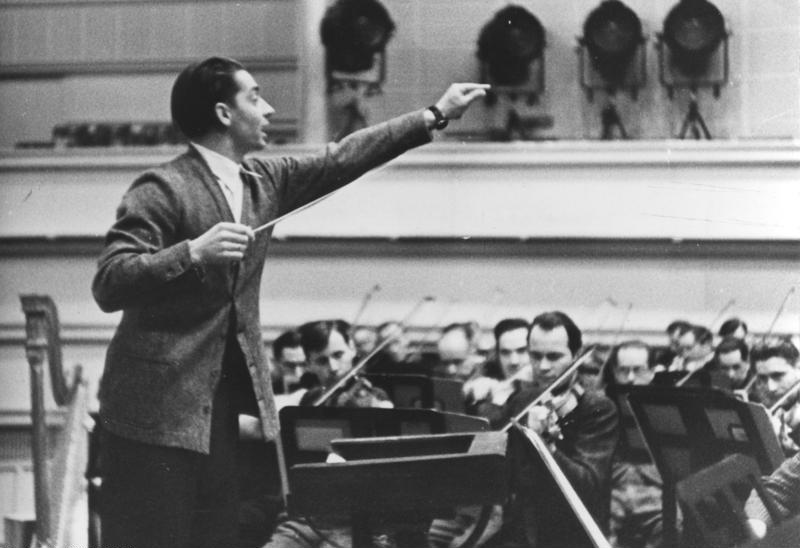
Method
21 participants (7 conductors, 7 pianists and 7 non-musicians) took part in the study. In turn, they sat in front of the arc of speakers and listened to a stream of short bursts of ‘pink noise’, with occasional equally short bursts of a richer bandwidth ‘red noise’, delivered via all the speakers in random order.
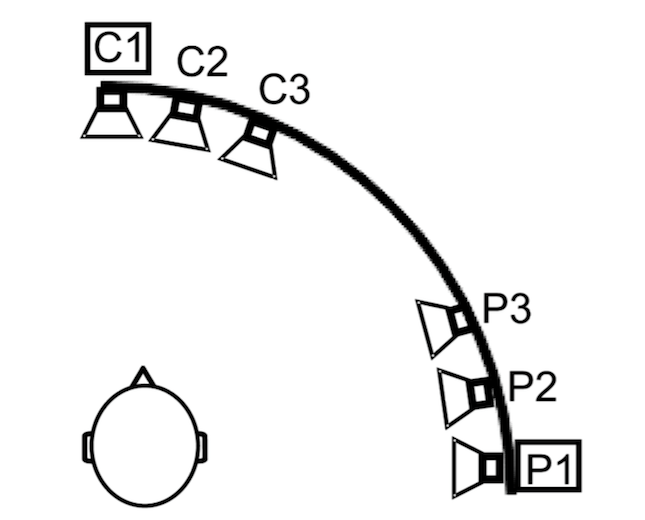
They were asked to attend either to the speaker positioned at ’12 o’clock’ (called ‘C1’ in the diagram) or the one positioned at ‘3 o’clock’ (‘P1’), pressing a button every time the attended speaker broadcast a burst of ‘red noise”. All ‘pink noise’ bursts from the nominated speaker were to be ignored. Correct button presses, and ‘false alarms’ where the ‘red noise’ had in fact come from a neighbouring speaker, were all recorded.
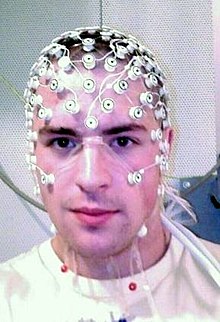
Throughout the experiment an electroencephalogram (EEG) was recorded via electrodes mounted in an electrode cap.
Results and discussion
Button-pressing
When asked to attend to the ’12 o’clock’ speaker (‘C1’) conductors, pianists and non-musicians all did well in spotting ‘red noise’ bursts emanating from it. And ‘red noise’ bursts coming from neighbouring speakers (‘C2’ and ‘C3’) rarely got misidentified as coming from ‘C1’.
But when asked to attend to the ‘3 o’clock’ speaker (‘P1’), pianists and non-musicians were significantly worse than the conductors at knowing whether the ‘red noise’ bursts were coming from that speaker or from neighbouring speakers ‘P2’ and ‘P3’.
In short, all listeners could attend well to a speaker in front of them, but conductors were better than non-musicians and pianists at attending to a speaker in their periphery.
Brain activity (EEG) on hearing ‘pink noise’ bursts
When attending to the ’12 o’clock’ (‘C1’) speaker, all listeners (non-musicians, pianists and conductors) exhibited a pattern of electrical brain activity called an ‘Event Related Potential’ (ERP) in response to a ‘pink noise’ burst from that speaker (the ERP is the solid line trace below):

On hearing a burst of ‘pink noise’ from a speaker (‘C3’) near to the 12 o’clock position, but while still attending only to the 12 o’clock speaker (‘C1’) itself, this ERP was diminished in all the groups of listeners (again the ERP is the solid line trace below):

So far, all three groups of listeners are showing pretty similar brain activity, and all show diminished ERPs when the noise isn’t coming from the speaker they are attending to. But differences emerge between the groups when asked to attend to the ‘3 o’clock speaker’ (‘P1’); these are the ERPs (this time represented by a dotted line, please ignore the solid line) when a burst of ‘pink noise’ came out of the ‘3 o’clock’ speaker itself:

And these are the ERPs when the ‘pink noise’ burst came out of a neighbouring speaker (‘P3’) whilst the listeners were still attending only to the ‘3 o’clock’ speaker (‘P1’) (again, it’s the dotted line):

It’s clear from the dotted lines that the controls (non-musicians) and the pianists have pretty much the same ERPs in response to a burst of ‘pink noise’ whether it comes from the ‘3 o’clock’ speaker (‘P1’) to which they are attending or a neighbouring speaker (‘P3’) to which they are not attending. But the conductors have a strong ERP response to the noise only if it comes from the ‘3 o’clock’ speaker (‘P1’) to which they are attending; their brains seem able to discriminate between this speaker (‘P1’) and its close neighbours (e.g. ‘P3’).
In summary, if a listener is focussed on a speaker (‘C1’, 12 o’clock position) placed directly in front of them, they will not confuse noises from neighbouring speakers (e.g. ‘C3’) as coming from ‘C1’, whether they are a non-musician, a pianist or a conductor. But if a listener is focussed on a speaker (‘P1’, 3 o’clock position) placed in their periphery, they might well think that noises from neighbouring speakers (e.g. ‘P3’) are coming from ‘P1’…..unless, it seems, that listener is a conductor.
Incidentally, the authors note that “this rather good behavioural and electrophysiological selectivity for sounds in peripheral space” exhibited by conductors is reminiscent of “previous findings obtained in a similar experiment with blind subjects”.
Brain activity (EEG) on hearing the occasional ‘red noise’ bursts
When attending to the speaker straight in front of them at ’12 o’clock’ (‘C1’), a ‘red noise’ burst from that speaker – unexpected amongst the much more common ‘pink noise’ bursts – evoked a large ERP in all listeners, but much bigger in musicians (pianists and conductors) than non-musicians, giving rise to big dips called, in EEG parlance, ‘P300’s (see the solid line traces below):

And when attending to the speaker at ‘3 o’clock’ (‘P1’) a red noise burst from that speaker evoked a smaller ERP in all listeners; but note the ‘P300’ dip is still quite ‘robust’ in conductors (again it’s the solid line traces):

This ‘P300’ component of an EEG wave form is known to be associated with detecting a ‘target’ stimulus, in this case a ‘red noise’ burst in amongst lots of ‘pink noise’ bursts. It seems from the ERP recordings that pianists and conductors are good at such detection when the speaker is directly ahead of them; but conductors are better able than pianists to do so when the noises come from the periphery.
Brain activity (EEG) on hearing ‘red noise’ bursts from speakers to which listeners aren’t paying attention
When paying attention to the ’12 o’clock speaker’, what are the ERPs when ‘pink noise’ bursts and ‘red noise’ bursts come instead from the ‘3 o’clock’ speaker?
For non-musicians (controls) the response to such unattended ‘pink noise’ bursts (dotted line) and ‘red noise’ bursts (solid line) are fairly similar:
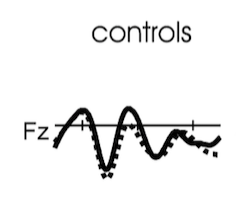
But pianists show a much bigger peak on hearing the unexpected ‘red noise’ burst compared with when hearing the ‘pink noise’ bursts. This peak is called, in EEG parlance, a ‘Mismatch Negativity’ (MMN); MMN peaks commonly occur when a sequence of repetitive sounds (here the ‘pink noise’ bursts) is interrupted by an occasional ‘oddball’ sound (here a ‘red noise’ burst) :
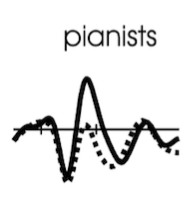
The conductors went even further – they exhibited an MMN peak, and then a dip, called a ‘P3a’. ‘P3a’ dips are associated with the engagement of attention – it would seem that the conductors are noticing the ‘red noise’ burst in their periphery and then turning their attention towards it:
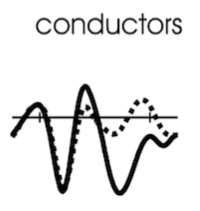
Conclusion
In the words of the Wido Nager and his fellow authors: “the present results not only show a clear difference between musician and non-musician subjects, they also demonstrate that among professional musicians of comparable experience it matters what ‘role’ or specialisation a particular musician has. [….] behavioural and ERP-data suggest that conductors are much better than pianists and non-musicians in attentively focussing in on relevant auditory information in space. Moreover, they also appear superior in the […] registration of deviant stimuli outside the attentional focus.”
Coda
Bill Haley and his Comets
It would be interesting to try this experiment with some orchestral players to see if they reacted similarly to conductors.
Thanks for feedback Gillian and yes I agree with you; it’s also the consensus of opinion in Facebook comments. I reckon orchestral pianists would be an ideal comparison, but they’re a rare breed!